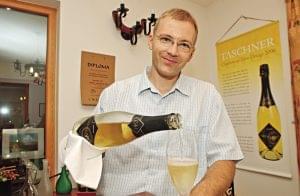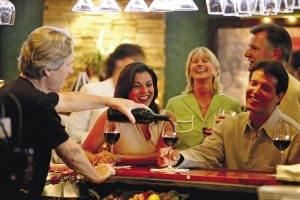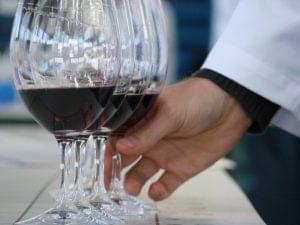A golden age – with certain limitations
Our magazine asked some of the most important players in the Hungarian wine sector about the current market situation. Márton Elek, director of strategy of Borháló Borkereskedés told us that many new wineries have appeared on the scene. Thanks to European Union funding, many wineries had the chance to invest in technological development. Consumers have become more conscious and sophisticated. In the last 12 months Borháló shops hosted more than 300 wine tasting sessions and the wine trader also launched an online wine course. Mr Elek added that every winery is concentrating on its own target group, and it is the feedback from them which influences the winery’s decisions.

Márton Elek
director of strategy
Borháló
Consumers continue to buy fragrant, fruity wines in large quantities. Gergő Soltész, president-director of Ostorosbor revealed that the economic recession has made consumers consider more factors before buying a bottle of wine. His view is that wineries which are able to come out with products of the same good quality all the time have the chance to perform very well in the market. Ostorosbor is happy to see that people know more and more about wines. Irsai, rosé wines and frizzantes of the company sell very well. Gergő Gelencsér, chief winemaker of Canter Borház highlighted the fact that in the last 10 years some wineries built production facilities using world-class technology from EU money. He added that fragrant, fruity and light wines made with reductive technology are the most important innovation direction – this is the type young consumers like.

Gergő Soltész
president-director
Ostorosbor

Gergő Gelencsér
chief winemaker
Canter Borház
According to Ágnes Tulik, marketing and communications manager of Törley, shoppers are buying more and more consciously, and the media plays an important role in this trend. Consumers like to try new wines, to discover new wineries and products. She thinks it isn’t enough to build a brand any more, it also has to be taken care of and prices need to be given adequate attention. Demand has been on the rise for rosé wines for quite a few years now. Kurt Taschner, owner of Taschner Bor- és Pezsgőház Kft. isn’t very optimistic: in his view the Hungarian wine market is in a state of stagnation or perhaps the situation even worsened a little in the last year and a half, because fewer consumers can afford buying quality products. The position of white wines has strengthened, but sales of light red wines are also growing.

Ágnes Tulik
marketing and communications manager
Törley

Kurt Taschner
owner
Taschner Bor- és Pezsgőház
Mr Elek believes that Hungarian wines can only become better known and recognised if wine growing regions start to cooperate, and if steps are taken at national level as well to promote products.
Mr Gelencsér talked to our magazine about the difficulty of setting collective targets in a given wine region, because various wineries make different wines with different kinds of markets in mind. Mr Taschner shares the view that collective marketing at wine region level is of utmost importance. However, based on the experience of the last few years, it is only worth doing if marketing work concentrates on wineries which are already successful to a certain extent. It is also key to put enough wine from the given region on the market, as marketing activities can’t be effective if the wines don’t reach the buyers. Mr Soltész talked to Trade magazin about their wine region’s efforts to promote Debrői Hárslevelű wines.

Ms Tulik was glad to see at the ProWein trade fair that the Hungarian stand had a new design and a new concept. Unfortunately, her experience is that due to the lack of an efficient Hungarian wine marketing strategy, our wines can still be found on the lower shelves in supermarkets abroad. Wine brands which are strong in Hungary can only be sold abroad in limited channels and in low volume, because these brands are unknown to international consumers and the prices of products are high. Mr Márton explained that the problem is that Hungary is small and the wine regions don’t stand united when it comes to marketing their products. Hungary can produce many types of wines, but no wine region is big enough to produce in volumes with which foreign markets can be conquered.

Mr Soltész is of the opinion that Hungarian wines are hardly known on the international stage. He thinks that we need to spend more on wine marketing, even more so because from relatively small budgets great opportunities can arise. Me Gelencsér’s view is that opinions are mixed on the quality of Hungarian wines. He reckons that the way to go for Hungarian wineries is to promote premium quality products in the international market. Another solution is to invest in hospitality and tourism: instead of exporting wines, bringing foreign wine lovers to Hungary and showing them what we have here, selling them premium products at premium prices. Ms Tulik reckons that the use of special wine packaging solutions is spreading slowly in Hungary. She told that it was more than ten years ago that they had started to export wine to Sweden in bag-in-box packaging, while in Hungary sales of this format only became measurable last year. Now the Szent István Korona brand’s Irsai Olivér and Rosé wines are available in 3-litre bag-in-box packaging. Mr Gelencsér informed that in addition to 3-, 5- and 10-litre bag-in-box products, they also sell wine in POST-Mix format to hotels. Mr Soltész revealed that their ‘Soltész’ wine range – launched at the end of last year – has been very successful. This spring they came out with a rosé frizzante product, Gyöngyöző. //
Related news
Hungarian wine is also an excellent choice for a Christmas gift
🎧 Hallgasd a cikket: Lejátszás Szünet Folytatás Leállítás Nyelv: Auto…
Read more >AM: with the support of the government, the administration of the grape and wine sector rests on a stable foundation
🎧 Hallgasd a cikket: Lejátszás Szünet Folytatás Leállítás Nyelv: Auto…
Read more >The government remains committed to supporting wine producers
🎧 Hallgasd a cikket: Lejátszás Szünet Folytatás Leállítás Nyelv: Auto…
Read more >Related news
Christmas shock in commerce: for the first time, we can pay with bank cards in fewer places
🎧 Hallgasd a cikket: Lejátszás Szünet Folytatás Leállítás Nyelv: Auto…
Read more >Hungarian Confectionery Manufacturers Association: trends in 2025 and prospects for 2026
🎧 Hallgasd a cikket: Lejátszás Szünet Folytatás Leállítás Nyelv: Auto…
Read more >Most grocery chains will be open until noon on December 24th
🎧 Hallgasd a cikket: Lejátszás Szünet Folytatás Leállítás Nyelv: Auto…
Read more >






